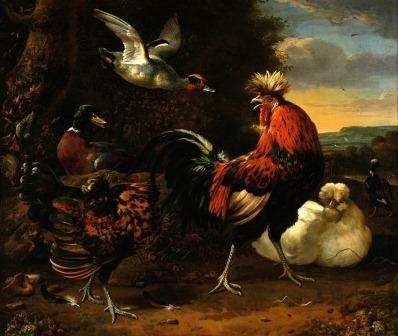In this case, an information request from the Origins Unknown Agency (BHG) about a single work of art eventually led to the restitution of two works to the daughter of the original owner.
During the investigation into The Penitent Saint Peter by G. Reni (NK 2863), which was in storage at the depot of the Netherlands Institute for Cultural Heritage at the time, the BHG discovered that during the war, the work had been in the possession of Erwin Samuel Simon. Simon had died in 2001, but the BHG managed to trace his daughter. In October 2004, she was asked to provide additional information about the painting by G. Reni. When searching through the family archive, she discovered letters that referred to another painting, namely Poultry by M. d’Hondecoeter. It emerged that that painting was also part of the Netherlands Art Property Collection (NK 1985) and on long-term loan to the Centraal Museum in Utrecht. In February 2005, Simon’s daughter applied for the restitution of both paintings.
It became clear that Simon, of Jewish extraction, had lived in Berlin until 1938 and had been in possession of a collection of art. As a consequence of anti-Jewish legislation, he and his wife left Berlin in 1938 and moved to the Netherlands, where they took an active part in the resistance movement during the occupation. From the end of 1943, they were forced to go into hiding, during which period their daughter was born. The family was arrested in 1944 but survived the war.
Sufficient material was available in the archive, allowing the Committee to conclude that the claimed paintings by Reni and d’Hondecoeter had been in Simon’s possession at the beginning of the war. For example, the archive contained an invoice pertaining to the painting by G. Reni from the archive of ‘Kunsthandel Voorheen J. Goudstikker N.V.’ (Gallery formerly known as J. Goudstikker N.V.), established in Amsterdam and run by the German Alois Miedl, showing that Simon had sold them the work in February 1941. The applicant was able to prove that her father had sold the d’Hondecoeter painting to Amsterdam art dealers Paul Cassirer & Co in April 1942. The painting eventually ended up in Germany and was returned in 1947. After the war, Simon made several attempts at regaining the d’Hondecoeter painting from the Dutch authorities but they came to nothing. The condition made by the authorities, namely the repayment of the proceeds received at the time, was probably the reason for this.
In its recommendation of 24 April 2006, the Committee considered it plausible that Simon had sold the paintings involuntarily, and that as a stateless resident of Jewish origin, Simon was not in a position to practise his profession in the Netherlands and was therefore forced to sell the works of art to support his family. The Committee therefore recommended that both paintings be returned. In accordance with the fourth recommendation regarding private art property, the Committee did not attach the condition that the proceeds received at the time be repaid, considering it plausible that Simon had had to use these funds for his impending escape into hiding and hence was not free to use these proceeds at his own discretion. Of particular interest in this case was that the Committee also included in its considerations the fact that in 1951, the State of the Netherlands had auctioned a work by Jan Steen that had belonged to Simon and which the latter had sold under pressure of war. After it had been recovered, the painting was sold for the benefit of the national treasury, and Simon was neither informed about this nor did he receive any compensation.
In a decision taken on 17 May 2006, the State Secretary adopted the recommendation.
